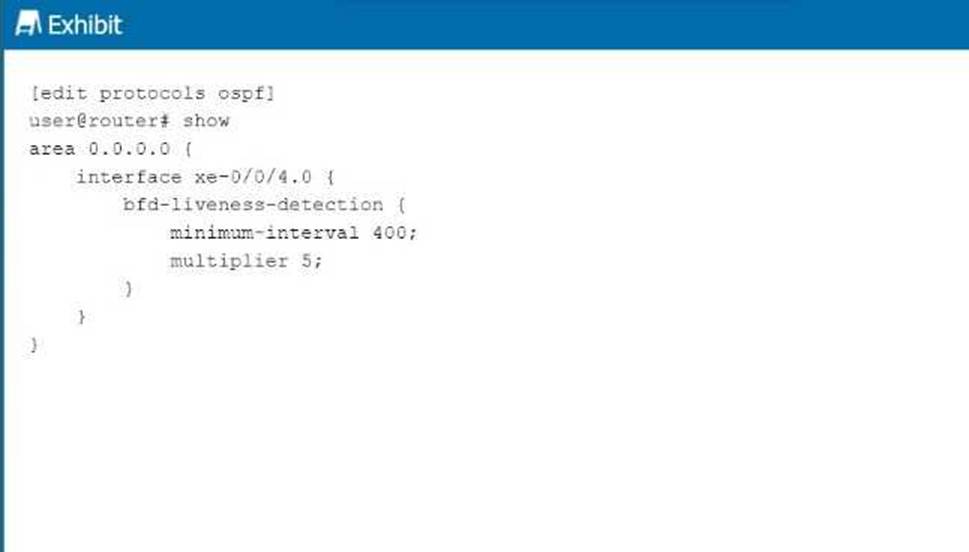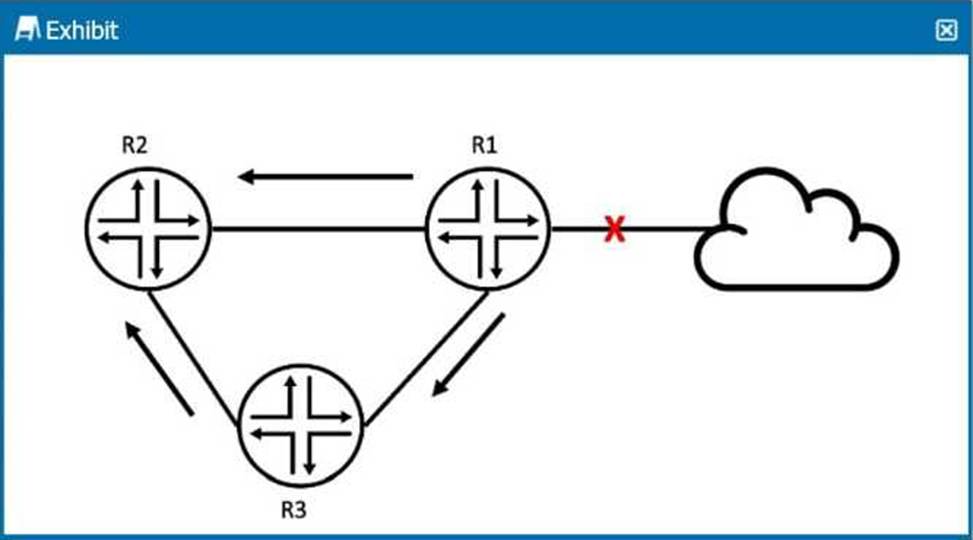Practice Free JN0-281 Exam Online Questions
When evaluating BGP routes, what will be evaluated first?
- A . The local preference value
- B . The AS path
- C . The MED value
- D . The origin value
A
Explanation:
In BGP (Border Gateway Protocol), when evaluating multiple routes to the same destination, the first attribute that is considered is the local preference value. The local preference is a BGP attribute used to influence outbound routing decisions within an Autonomous System (AS).
Step-by-Step Breakdown:
Local Preference:
The local preference attribute is used to determine which path is preferred for traffic leaving the AS.
The higher the local preference value, the more preferred the route.
BGP Path Selection:
The BGP path selection process evaluates the following attributes in this order:
Local Preference (higher is preferred)
AS Path (shorter is preferred)
Origin (IGP > EGP > incomplete)
MED (Multi-Exit Discriminator) (lower is preferred)
Juniper
Reference: BGP Path Selection: In Junos, the local preference attribute is the first to be evaluated when determining the best path for outbound traffic.
Exhibit:

Referring to the exhibit, at which interval will the interface be considered down if no hello packets are received?
- A . 2000 seconds
- B . 400 milliseconds
- C . 400 seconds
- D . 2000 milliseconds
D
Explanation:
The exhibit shows the configuration of Bidirectional Forwarding Detection (BFD) for OSPF on interface xe-0/0/4.0, with the following parameters: minimum-interval: 400 milliseconds
multiplier: 5
Step-by-Step Breakdown:
BFD Liveness Detection:
BFD is used to detect link failures at sub-second intervals, providing faster convergence times for routing protocols like OSPF. The minimum-interval is the time between BFD control packets (in milliseconds), and the multiplier indicates how many missed BFD packets trigger a failure.
Calculating Failure Detection Time:
The failure detection interval is calculated as:
Failure Interval=minimum-interval×multipliertext{Failure Interval} = text{minimum-interval} times text{multiplier}Failure Interval=minimum-interval×multiplier In this case:
400 milliseconds×5=2000 milliseconds(2seconds)400 , text{milliseconds} times 5 = 2000 , text{milliseconds} (2 seconds)400milliseconds×5=2000milliseconds(2seconds) Conclusion:
If no BFD control packets are received within 2000 milliseconds (2 seconds), the interface will be considered down, triggering OSPF to recalculate routes. Juniper
Reference: BFD Configuration: BFD parameters such as minimum-interval and multiplier are used to fine-tune the failure detection time for faster convergence.
MACsec provides protection against which two types of threats? (Choose two.)
- A . Data decryption
- B . Playback attacks
- C . Hashing attacks
- D . Man-in-the-middle attack
B, D
Explanation:
MACsec (Media Access Control Security) provides data confidentiality, integrity, and origin authenticity at Layer 2, protecting against several types of threats.
Step-by-Step Breakdown:
Man-in-the-Middle Attack Protection:
MACsec encrypts traffic at Layer 2, preventing man-in-the-middle attacks where an attacker intercepts and manipulates traffic between two communicating devices. Since the data is encrypted, any intercepted packets are unreadable.
Protection Against Playback Attacks:
MACsec also protects against playback attacks by using sequence numbers and timestamps to ensure that old, replayed packets are not accepted by the receiver. Juniper
Reference: MACsec Configuration: Juniper devices support MACsec for securing Layer 2 communications, ensuring protection against replay and man-in-the-middle attacks in sensitive environments.
What is the default route preference of a static route in the Junos OS?
- A . 0
- B . 10
- C . 1
- D . 5
D
Explanation:
In Junos OS, the default route preference for a static route is 5. Route preference values are used to determine which route should be installed in the routing table when multiple routes to the same destination are available.
Step-by-Step Breakdown:
Static Route Preference:
A static route, by default, has a preference of 5, making it a highly preferred route. Lower preference values are more preferred in Junos, meaning static routes take precedence over most dynamic routing protocol routes, such as OSPF (preference 10) or BGP (preference 170).
Route Preference:
Route preference is a key factor in the Junos routing decision process. Routes with lower preference values are preferred and installed in the forwarding table.
Juniper
Reference: Static Routes: In Junos, the default preference for static routes is 5, making them more preferred than most dynamic routes.
Which state in the adjacency process do OSPF routers check the MTU size?
- A . Init
- B . Exchange
- C . Done
- D . ExStart
B
Explanation:
In OSPF, routers exchange link-state information in different stages to establish full adjacency.
The MTU size is checked during the Exchange state.
Step-by-Step Breakdown:
OSPF Adjacency Process:
OSPF routers go through multiple stages when forming an adjacency: Down, Init, 2-Way, ExStart,
Exchange, Loading, and Full.
Exchange State:
During the Exchange state, OSPF routers exchange Database Description (DBD) packets to describe their link-state databases. The MTU size is checked at this stage to ensure both routers can successfully exchange these packets without fragmentation.
If there is an MTU mismatch, the routers may fail to proceed past the Exchange state.
Juniper
Reference: MTU Checking in OSPF: Junos uses the Exchange state to check for MTU mismatches, ensuring that routers can properly exchange database information without packet fragmentation issues.
You are creating an IP fabric underlay and want to use OSPF as your routing protocol.
In this scenario, which statement is correct?
- A . All leaf devices must be configured in separate OSPF areas.
- B . All leaf and spine devices must be the same model to ensure the proper load-balancing behavior.
- C . Interface speeds should be the same throughout the fabric to ensure that all links are utilized.
- D . All spine devices must use the same router ID.
C
Explanation:
When creating an IP fabric underlay using OSPF as the routing protocol, consistent interface speeds are important to ensure optimal traffic distribution and utilization of all links.
Step-by-Step Breakdown:
OSPF and Interface Speeds:
OSPF calculates the cost of a link based on its bandwidth.
The default cost calculation in OSPF is:
![]()
If interface speeds vary significantly, OSPF may choose paths with lower cost (higher bandwidth), resulting in some links being underutilized.
Equal Utilization:
To ensure that all links are equally utilized in an IP fabric, it is recommended to maintain uniform interface speeds across the fabric. This ensures balanced load sharing across all available paths. Juniper
Reference: IP Fabric with OSPF: Juniper recommends consistent interface speeds to maintain even traffic distribution and optimal link utilization in IP fabric underlay designs.
What are two consequences of having all network devices in a single collision domain? (Choose two.)
- A . The amount of network resource consumption does not change.
- B . The chance of packet collision is decreased.
- C . The chance of packet collision is increased.
- D . The amount of network resource consumption is increased.
C, D
Explanation:
A collision domain is a network segment where data packets can "collide" with one another when being sent on the same network medium.
Step-by-Step Breakdown:
Increased Collision Probability:
If all devices are in a single collision domain, the likelihood of packet collisions increases as more devices attempt to send packets simultaneously, leading to network inefficiencies. Increased Resource Consumption:
More collisions result in increased network resource consumption as devices need to retransmit packets, causing higher utilization of bandwidth and slowing down network performance. Juniper
Reference: Collision Domains: Proper network segmentation using switches reduces collision domains, thereby improving network performance and reducing packet collisions.
Exhibit:

R2 received an OSPF update from R1, and it received the same update from R3.
Referring to the exhibit, what will R2 do?
- A . R2 ignores the update from R1.
- B . R2 does nothing with R3’s update.
- C . R2 ignores the update from R3.
- D . R2 acknowledges R3 and discards it.
C
Explanation:
In the exhibit, R2 receives the same OSPF update from both R1 and R3. OSPF has mechanisms to prevent unnecessary processing of duplicate LSAs (Link-State Advertisements).
Step-by-Step Breakdown:
OSPF LSA Processing:
OSPF uses LSAs to exchange link-state information between routers. When a router receives an LSA, it checks if it already has a copy of the LSA in its Link-State Database (LSDB).
Duplicate LSAs:
If R2 has already received and processed the update from R1, it will ignore the update from R3 because it already has the same LSA in its database. OSPF uses the concept of flooding, but it does not reprocess LSAs that it already knows about.
R2 Behavior:
R2 will keep the update from R1 (the first one it received) and will ignore the same LSA from R3, as it
is already in the LSDB.
Juniper
Reference: OSPF LSA Processing: Junos adheres to OSPF standards, ensuring that duplicate LSAs are not processed multiple times to avoid unnecessary recalculations.
Which three technologies improve high availability and convergence in a data center network? (Choose three.)
- A . graceful restart (GR)
- B . Bidirectional Forwarding Detection (BFD)
- C . link loss adjacency
- D . Failover Group (FG)
- E . link aggregation group (LAG)
A, B, E
Explanation:
High availability and fast convergence are critical in data center networks to minimize downtime and maintain optimal performance.
The following technologies contribute to achieving these goals:
Graceful Restart (GR):
GR allows routers to maintain forwarding state during control plane restarts, ensuring continuous packet forwarding while minimizing network disruptions.
Bidirectional Forwarding Detection (BFD):
BFD provides fast detection of path failures, allowing routing protocols to converge quickly by detecting link failures much faster than traditional timers.
Link Aggregation Group (LAG):
LAG increases both redundancy and bandwidth by combining multiple physical links into one logical
link, providing load balancing and fault tolerance.
Juniper
Reference: High Availability Techniques: These technologies are fundamental in ensuring rapid recovery and failover within Juniper-based data center environments.
By default, which two statements are correct about BGP advertisements? (Choose two.)
- A . BGP peers advertise routes received from EBGP peers to other IBGP peers.
- B . BGP peers advertise routes received from IBGP peers to other IBGP peers.
- C . BGP peers advertise routes from EBGP peers to other IBGP peers using its own address as the next hop.
- D . BGP peers advertise routes from IBGP peers to EBGP peers using its own address as the next hop.
A, D
Explanation:
BGP (Border Gateway Protocol) has specific rules for route advertisement between peers.
Step-by-Step Breakdown:
EBGP to IBGP Route Propagation:
BGP peers advertise routes learned from EBGP peers to IBGP peers within the same AS. This ensures that routes learned from external networks are propagated internally within the AS. IBGP to EBGP Route Propagation:
Routes learned from IBGP peers can be advertised to EBGP peers, but when advertising these routes, the router uses its own IP address as the next hop.
IBGP Split Horizon:
By default, IBGP peers do not advertise routes learned from one IBGP peer to another IBGP peer.
This rule (IBGP split horizon) prevents routing loops within an AS.
Juniper
Reference: BGP Advertisement Rules: Junos adheres to BGP standards, where IBGP peers do not propagate routes to other IBGP peers, but EBGP peers receive IBGP routes with the advertising router as the
next hop.
